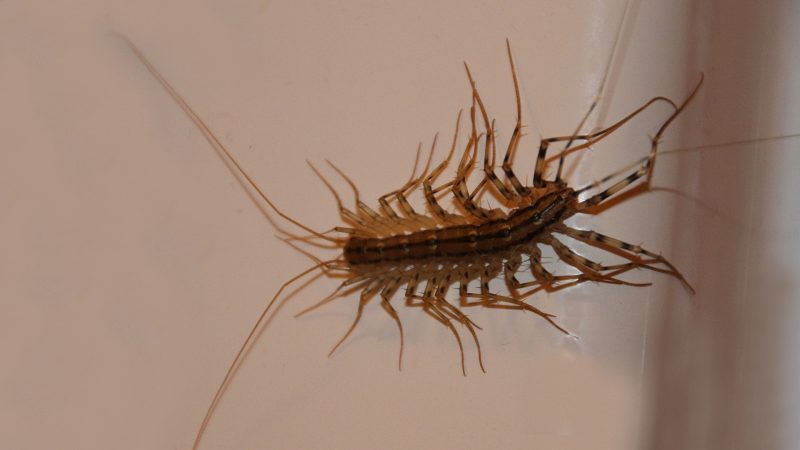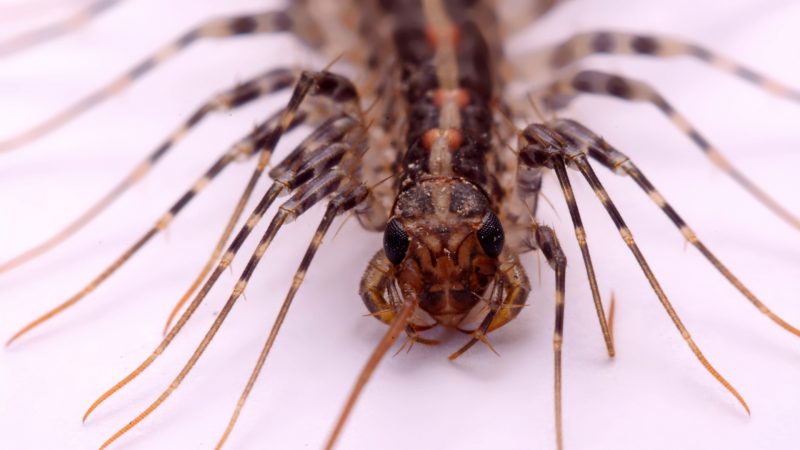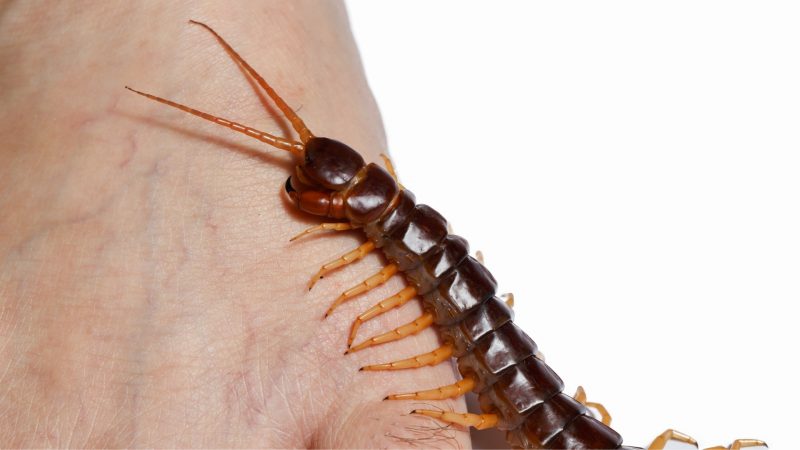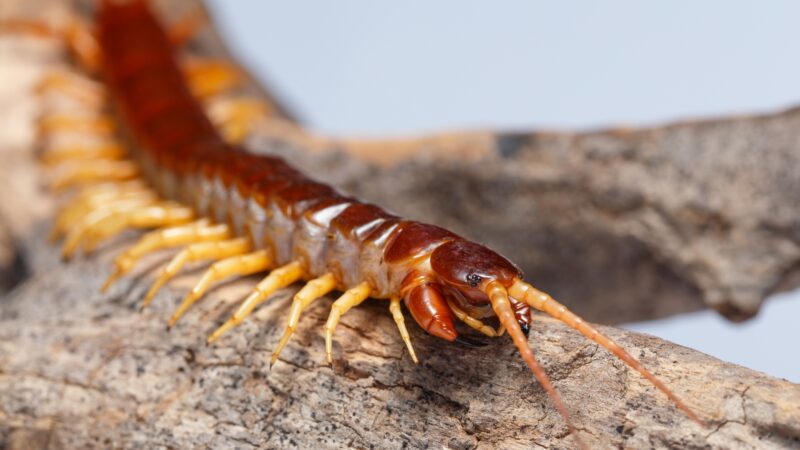When you visit the bathroom at night and see a creepy centipede scurrying along the walls, you’ll immediately want to get rid of them. Nobody wants a multi-legged venomous creature running around their house. But can centipedes bite you, and are they poisonous?
Do centipedes bite humans and are they poisonous? Centipedes can bite humans, typically only when provoked. They have sharp, clawed legs that they use to pierce the skin when they bite. If you pick them up or handle them roughly, they might bite you. In addition, if you walk on one by mistake, they could bite.
If centipedes leave you quaking in fear, this article will help you relax. If you were thinking about getting a giant centipede as a pet, this article might cause you to think twice. Whatever your reasons for reading, when you’re done, you’ll know more about this venomous animal and why it spends so much time in your basement and bathroom.
What Do Centipedes Look Like?
A centipede’s body is typically yellowish to dark brown in color, with occasionally deeper stripes or patterns. Their heads are equipped with a pair of long, sensitive antennae that are densely coated with hair. They feature enormous, claw-like structures with small mouths that house venom glands.
Additionally, centipedes can be as small as 1 inch long or as large as 7 inches. There might be as few as 15 pairs of legs on a centipede or as many as 177.
Although they may live in deserts and other arid environments, centipedes prefer dark, moist environments and humid climates. They are nearly everywhere in the world.
Why Do I Keep Seeing Centipedes in My Bathroom?

Centipedes lack the wax coating that helps insects and spiders survive in dry conditions. That means they must stay moist at all times. When they come to your house, they seek the coolest places with the highest humidity. That means they’re most often found in your bathroom or basement.
Do Centipedes Bite or Sting?
Technically, centipedes do neither bite nor sting. They pinch with their sharp front legs. Though these are often mistaken for teeth, they’re not part of the centipede’s mouth.
The centipede’s unique venomous front legs evolved over 430 million years ago. Centipedes are the only animals with forcipules, which contain venom glands. Their front legs form sharp pincers just behind their head, and they use it to inject venom and hold their captured prey.
Related: Common House Centipedes | All You Need to Know!
What Does a Centipede Bite Look Like?
You can expect to see a bit of swelling and redness in a centipede bite. Were it not for the distinctive V-shape of the wound, centipede envenomation would look like a bee sting. A more severe case might cause more significant swelling, and in the case of a very bad envenomation, you might see some ulceration and blackened necrotic tissue around the injury.
Keep in mind that these would be exceptionally horrible cases. Those wounded by a big Scondoleptra report a great deal of pain, but not much tissue damage or lasting effect.
Are House Centipedes Venomous?

House centipedes are venomous, but they aren’t poisonous. Poisonous animals like the Fugu puffer sicken or kill predators that eat them, while venomous animals like rattlesnakes or bees inject venom into a target.
Some introduce their toxins through a bite, others use specialized stingers, and centipedes use very sharp front legs.
The house centipede (Scutigera coleoptrata) is an early venom adopter, even before scorpions and spiders. And of all the centipedes, the house centipede and its relatives most closely resemble the earliest centipedes. (The other centipede families are a mere 340 to 370 million years old).
Though centipede venom is ancient, it remains little studied. Centipedes produce only very tiny quantities. The large and aggressive tiger centipede (Scolopendra polymorpha), found in the North American southwest and noted for its painful bite, produces a bit over one microliter of venom. That’s one-millionth of a liter or 1/4982 of a teaspoon.
How Do Centipedes Bite?
A centipede leaps atop its prey and clutches it with multiple legs. As the forcipules pierce the prey’s skin, venom glands at the forcipule base squeeze out a cocktail of toxins that flow into the hapless victim through holes in the forcipule.
These toxins act fast on the centipede’s usual prey. A house centipede’s attack will kill a bedbug, spider, or roach within seconds. A giant Vietnamese centipede (Scolopendra subspinipes) can dispatch a mouse in under a minute.
Centipede Bite Marks
A pinch from a house centipede will generally leave no marks at all. House centipedes have slender forcipules which can slice through a moth but will have a hard time piercing human skin. However, a pinch from an especially large house centipede or a bigger centipede species will leave a distinctive v-shaped mark on the bite area.
What Happens if a Centipede Bites You?

If a house centipede bites you, you probably won’t notice anything more than an annoying pinch. If it manages to break your skin, you may feel a burning sensation and some itching.
A pinch from a tiger centipede’s forcipules will feel more like a bee sting, so you can expect some swelling and redness. If you’re keeping one of the Asian giant centipedes, things could be worse. Centipede keepers describe a Vietnamese giant centipede envenomation as “like someone was slamming his hand in a car door over and over and over again.”
Are House Centipedes Dangerous?
House centipedes are very dangerous to a bedbug or silverfish. They move very quickly on their 15 long legs, and they can grip more than one prey item with those legs while grabbing and striking another with their forcipules. Even wasps are no match for this fast-moving venomous predator.
On the other hand, house centipedes are less dangerous to humans than cockroaches or fleas. Cockroaches can spread dysentery and typhoid fever, and fleas brought Europe the Black Death. House centipedes don’t carry diseases and kill both cockroaches and fleas.
House Centipede Bite Symptoms

You’ll most likely see no symptoms at all from a house centipede bite. At worst, you’ll experience mild pain and itching. There are very few medical reports regarding house centipede bites, and the existing literature describes very mild symptoms.
If you have a pre-existing sensitivity to bee venom, you may also have an allergic reaction to a centipede bite. Many of the proteins found in centipede venom also appear in the venom of yellowjackets, hornets, paper wasps, and fire ants. Consult your doctor if you begin feeling short of breath or start breaking out in hives.
For a mild to moderate centipede envenomation, you can expect pain and swelling. The wound area may itch and burn, and the skin around it may be tender, but this discomfort should go away within 24 to 48 hours. However, if the swelling begins moving upward or you start seeing signs of infection, consult a doctor immediately.
With a giant centipede envenomation, the swelling may extend through the entire limb. There may be intense, throbbing pain and red streaks in the skin caused by inflammation of the local lymph system. The area may become infected, and you may see necrosis (tissue death) around the wound.
An attack from an 8-inch (20.32-cm) centipede will be unpleasant, but even in these cases, most victims recover with little lasting harm. However, there have been sporadic reports of heart attacks, blood in the urine, rhabdomyolysis, or excessive bleeding. Secondary infections can also lead to complications.
Can a Centipede Bite Cause Death?
There are only a few medical records of house centipedes envenomating people. They describe episodes that were no more severe than a bee sting.
A centipede bite rarely causes death. There’s only one documented case of human death by a centipede. A seven-year girl in the Philippines was envenomated on the head by a Pacific giant centipede and died 29 hours later. That occurred back in 1932.
There have also been several other undocumented reports of centipede-related human deaths. But even so, it appears safe to say that even the worst centipede pinch won’t kill you. It’s, however, also safe to say that a giant centipede bite can be excruciatingly painful, based on numerous reports. You won’t die, but you probably might wish you had.
Centipedes are creepy and crawly. But most centipedes do more good than harm to the environment by eating other pests, such as cockroaches and fleas. Only a few centipede species have enough venom to hurt a human or even a dog. Their bites can cause swelling and pain, but an overwhelming majority of centipede bites heal without medical intervention.
Will Centipedes Bite Dogs or Other Pets?

The Pacific giant centipede (Scondoleptra subspinipes) is an invasive species in Hawai’i, which thrives in Hawaii’s warm, moist foliage. Dogs nosing around in the dirt may infrequently find themselves pinched by an aggressive centipede. Although there have been occasional reports of dogs going into anaphylactic shock, most recover without incident.
Veterinarians in Arizona and southern California occasionally treat dogs who have tangled with a tiger centipede. Most dogs will have some pain and swelling but recover within a few days. In most of the country, the local centipedes are small enough that dogs have nothing to fear.
What Should You Do if You’ve Been Bitten by a Centipede?
The bites of more hazardous insects can resemble those of centipedes. In particular, if your symptoms are severe and you are unsure of what bit you, consult a doctor.
Centipede bites can be treated at home if there are no complications by focusing on symptom relief:
- As soon as you can, warm the bite. Venom can be diluted by applying hot compresses or submerging the site in hot water.
- Swelling can be reduced by applying ice packs.
- Reduce inflammation, allergic responses, and pain with medicine. These consist of antihistamines, anesthetics, and pain relievers.
How To Treat a Centipede Bite?

If a centipede breaks your skin, do the following:
1. Disinfect the wound immediately. Secondary infections are a significant cause of complications in centipede injuries.
2. Apply a warm pack to the bite area immediately to encourage bleeding to flush out any remaining venom and break down harmful proteins in the poison.
3. Apply a cold pack to reduce swelling.
The worst of the pain should be over in a day or two. If the pain persists, or if you see signs of infection, ulceration, or necrosis, consult a medical professional immediately.
List of Sources
Ebeling, W. (2002). Urban Entomology Chapter 9, part 1: Pests Attacking Man and His Pets. Entomology UC Riverside.
Fenderson, J. L. (2014). Centipede Envenomation: Bringing the Pain to Hawai’i and Pacific Islands. Hawaii journal of medicine & public health.
Ross, E. J. et al. (2021). Centipede Envenomation. StatPearls Publishing.
Undheim, E. A., Fry, B. G., King, G. F. (2015). Centipede Venom: Recent Discoveries and Current State of Knowledge. Toxins.
- How to Get Rid of Copperheads | Practical Guide - August 27, 2023
- How to Get Rid of Corn Snakes | What Makes Them Aggressive? - August 27, 2023
- How to Get Rid of Alligators | Safety Measures and Removal Methods - July 16, 2023
